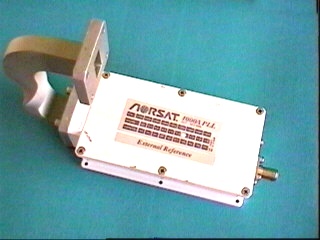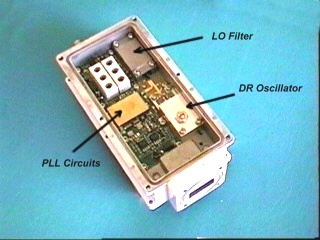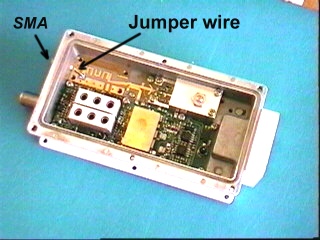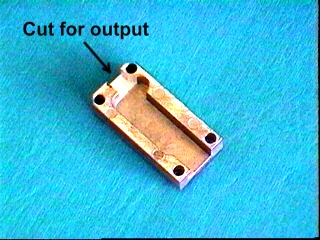A Satellite Converter with an Interesting LO
Last year (1997) I didn't make it out for the 10-GHz contest because my microwave local oscillator (LO) stopped working. I designed my radio for a high-side oscillator that I was able to find. I used some DMC RX and TX parts that were designed to create about 300 MHz IF. I then mixed again high-side to flip things back and convert to my comercial ham radio frequency. To keep the same design I needed to find an LO at about 10.680 GHz. As luck would have it, I stumbled on a solution at a flea market a few months ago.
Below are pictures of a satellite down converter I found recently. I know there were a few of these around, so maybe other hams have them. The ones I have seen all had a U-shaped waveguide (WR 75) on the input flange. It is labeled "NORSAT 1000A PLL" for 11.7 - 12.2 GHz. It also says "External Reference" on the cover. This sounded interesting. I wondered what the PLL and External Reference meant.
 |
 |
I opened up the covers and examined the circuits inside. One side contained the RF preamp, mixer, and block output amps. Per the cover, the low noise RF preamp is pretty good -- marked at 1.2 dB NF -- but that's not really what I wanted from this thing. The other side had a DRO (Dielectric Resonator Oscillator) for the LO. The oscillator output seemed to be sampled and ran into a little brass shielded box. This appeared to be some kind of PLL sampler for locking the oscillator to a reference.
I experimented and found that this was a standard satellite converter, but with an added twist. Most of these things convert the microwave signal down to about 1 GHz which is fed out through a 75 ohm TV-style connector. The same coax that feeds the output RF away is also used to supply DC voltage for the operation of the converter. I applied +15 Volts to the connector and found that by holding a probe near the open unit, I could detect an LO signal at around 10.8 GHz.
I thought that this thing might also be designed to pick up a reference frequency from the same output cable. I inserted a DC block on the output connector and fed an oscillator signal in (along with the blocked +15 Volts). Sure enough when I injected 10 MHz, the Local Oscillator in the unit locked to 10.750 GHz. Great trick, but unfortunately too high in frequency for me to use.
Maybe somehow I could modify the PLL counters to get a frequency I could use. I examined the circuit and didn't see anything that looked like a PLL counter chip. Could this be a simple injection mixer?
I soldered a wire on what appeared to be the control voltage signal for the DRO. I checked this signal. With no external reference this was a sawtooth and with the reference connected so the oscillator locked, it was about 10 V dc. Good so far -- now I had a way to monitor lock. I loosened the adjustment screw on the DRO cavity and started to turn. Lost lock… then lock… frequency now 10.740 GHz. Tune more. Loss… lock… 10.730. Cool! This thing locks every 10 MHz.
I was able to adjust it down to 10.690 and still maintain dependable oscillation with lock. This was good enough for me to use with my existing 10 GHz rig. Now I just needed to find a way to tap into the oscillator signal for output.
After the sampler out of the oscillator for the PLL, there was a printed filter in the main signal path. This must be designed for 10.750 but maybe it will pass signal at 10.690. I made some rough signal measurements on the mixer side at 10.750 and 10.690. The signal did not appear to be too far down, so I didn't attempt to modify the filter.
I found that there was enough room to add an SMA connector right at the end of the LO filter. I unsoldered the rod feeding the LO signal from the filter to the other board. This was hard to remove and I am not sure if it was necessary. I might not do this if I tried again. I drilled the case and added an SMA connector which I connected to the filter with a short piece of silver plated wire. All that was needed now was to cut a slot in the end of the filter cover to allow the wire to pass. The modifications are shown below.
 |
 |
By using a good 10 MHz ovenized reference oscillator to feed the converted unit I was able to use it as my microwave LO and stay right on frequency all day. That's a first for me and was a nice change -- eliminating the frequency uncertainty I usually had in the past.
In my application I made no use of the preamp or mixer in this unit. The only bad news was that the strength of the signal out through my added SMA connector was only about 0 to +1 dBm. I needed about +10 dBm so had to add an amplifier after this source before I could use the signal.
Well, I hope you found this interesting and I hope someone out there has one or two of these things and someone can put them to use besides me. If anyone wants more details on what I found or how I did this, please contact me. I'd be happy to give more details.